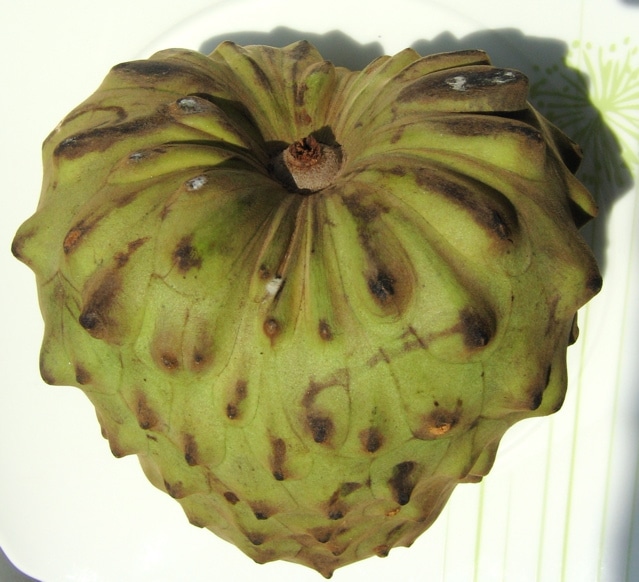Cherimoya:
What is it?, history, cultivation, nutritional value, uses, recipes, and more...
Cherimoya is a tropical fruit with refreshing and aromatic pulp, relatively round in shape and green in color. It is mainly consumed raw, although it is also used in jams, smoothies, ice creams, among many other industrial and culinary uses. It is a fruit rich in vitamins and minerals, making it highly beneficial for health.
Índice
What is Cherimoya?
According to the Food and Agriculture Organization (FAO), Cherimoya is of Andean origin, specifically from Ecuador, Colombia, Bolivia, and Peru. It grows at altitudes ranging from 1400 to 2000 meters.
This fruit was already cultivated during the Inca civilization, and the Moche tribe frequently depicted it in their ceramics. After the discovery of America, it was introduced to the East via Africa by the first Spanish navigators who named it “manjar blanco” upon discovering it.
Currently, cherimoya is grown worldwide, with Spain being the largest producer of this delicious fruit. Other major producers include Argentina, Peru, Australia, Bolivia, Chile, Colombia, Ecuador, the United States, Israel, South Africa, Spain, and Taiwan.
History of Cherimoya
According to the Food and Agriculture Organization (FAO), Cherimoya has its origins in the Andean region. That is, it comes from Ecuador, Colombia, Bolivia, and Peru, where it grows at altitudes ranging from 1400 to 2000 meters.
This fruit was already cultivated during the Inca civilization, and the Moche tribe frequently depicted it in their ceramics. Later, after the discovery of America, it was introduced to the East via Africa by the first Spanish navigators, who named it “manjar blanco” upon discovering it.
Currently, cherimoya is found all over the world, with Spain being the leading global producer of this delicious fruit. Other major producers include Argentina, Peru, Australia, Bolivia, Chile, Colombia, Ecuador, the United States, Israel, South Africa, Spain, and Taiwan.

Common name of Cherimoya
| Cuba | Anón de manteca |
| Guatemala | Anona pac, pap, tsummy o tzumux |
| El Salvador | anona, anona blanca, anona de tierra fría, anona poshte, cherimoya, chirimola, poshte |
| República Dominicana | cachimán |
| Venezuela | catuche chirimorrinón |
| Colombia | chririmoya |
| República Dominicana, Puerto Rico | cherimoya, cherimalla, chirimorrinón, cherimoyales, anona del Perú, chirimoyo del Perú, cachimán de la China, corazón |
| Cuba, República Dominicana, Puerto Rico | catuche, mamón |
| Guatemala | momona, girimoya, masa, pac |
| Haití | cachiman la Chine |
| Belize | pox |
| México | tukib |
| Inglés | Cherimoya, custard apple |
| Francés | Chérimole, corossol du Peérou |
| Italiano | Cerimolia |
| Alemán | Peruanischer flaschenbaum, cherimolia |
| Portugués | Chirimólia, cherimóia, cabeça de negro, anona do Chile, fruta do conde |
| Esperanto | Cêrimolio |
Scientific name of Cherimoya
Annona cherimola
Taxonomy of Cherimoya
| Reino | Plantae |
| División | Magnoliophyta |
| Clase | Magnoliopsida |
| Subclase | Magnoliidae |
| Orden | Magnoliales |
| Familia | Annonaceae |
| Subfamilia | Annonoideae |
| Tribu | Annoneai |
| Género | Annona |
| Especie | A. cherimola |
Synonymy of Cherimoya
Annona pubescens Salisb., 1796
Annona tripetala Aiton, 1789
Etymology of Cherimoya
The word “chirimoya” comes from the Quechua word “chiri,” which means “cold,” and “muya,” which means “seeds,” as this plant grows at high altitudes with low temperatures. In Quechua, it is spelled “chirimuya.”
As for its scientific name, “annona” is the Latinized generic name derived from “Anón,” the name of the fruit from the homonymous tree in Taíno. “Cherimola,” on the other hand, is the epithet that refers to its name in Quechua: “chirimuya.”
Cultivation, Distribution, and Habitat of Cherimoya
- Habitat
- Distribution
- Cultivation
Habitat of Cherimoya
Cherimoya is considered native to Peru and Ecuador, in areas ranging from 1500 to 2200 meters above sea level, where it is known to have been cultivated since 200 AD.
The main regions in Peru where cherimoya is produced are Cajamarca, Huánuco, Apurímac, and Junín, with the Department of Cajamarca having the highest genetic diversity of cherimoya.
Its cultivation has spread to all continents. For example, it is grown in different countries with a tropical climate such as Peru, Chile, Bolivia, Ecuador, Colombia, South Africa, and Israel. It is also cultivated in countries like the United States, South Africa, Thailand, Indonesia, Australia, and recently in New Zealand.
The cherimoya tree requires dry climates with moderate rainfall and temperatures that do not reach extreme heat or cold. When grown in hot regions, it rarely bears fruit, and the quality of the fruit is inferior. Additionally, below 14°C, the quality of the fruit significantly decreases, making it difficult to obtain edible fruits. It also does not thrive well in sandy-loamy soils but can grow optimally in other soil types as long as they are sufficiently fertile and well-drained.
The ideal conditions for obtaining good fruits are temperatures between 25 and 28°C and relative humidity between 60-70% during the flowering season. The average temperature for cultivating this species is 13°C during the coldest months.
Strong winds can also cause damage to the cherimoya tree, as its fragile and young branches can bend, resulting in poor tree formation.
The most suitable soil pH would be between 6.0 and 7.5.
Cherimoya Distribution
Cherimoya Cultivation
Geographical Distribution of Cherimoya

Cajamarca, Junín, Piura, Apurímac, Lima, Cuzco
Seasonal Availability of Cherimoya
- April, May, June, July, August
Varieties of Cherimoya
The most cultivated varieties of cherimoya come from hybrids, including:
-
Cherimoya Umbonata
-
Cherimoya Tuberculata
-
Cherimoya Mammillata
-
Cherimoya Impresa
-
Cherimoya Lisa
Nutritional Value of Cherimoya
Cherimoya contains small amounts of vitamins such as B1 and B2, and minerals like calcium, phosphorus, and iron. It is also rich in potassium, vitamin B6, and vitamin C. The latter participates in collagen synthesis, as well as bone and teeth health.
Cherimoya has a high vitamin content from the B group (no other fresh fruit has such high content of vitamins B1, B2, and B6). It is also a source of vitamin C and small amounts of vitamin A. It is notable for its carbohydrate content (20% of its weight), mainly consisting of simple sugars like fructose and glucose (around 11%) and sucrose (around 9%). It provides a significant amount of phosphoric acid and minerals such as calcium (30 mg per 100 g of edible portion), potassium (264 mg per 100 g of edible portion), and iron (0.4 mg per 100 g of edible portion).
Its fiber content (1.9 g per 100 g of edible portion) helps improve intestinal transit and benefits various diseases and conditions, while its protein content is 2%, higher than many other fruits.
Health Benefits of Cherimoya
Cherimoya provides the body with 32% of the daily recommended intake of vitamin C in just 100 grams of fruit.
Contraindications or Side Effects
It is not recommended to consume cherimoya in excess or shortly after a heavy meal, as it can cause an intestinal reaction and gastric bioelectric effect (due to the high sugar content of the fruit), leading to excessive intestinal peristalsis, gas, and discomfort. Additionally, due to its high sugar content, moderate consumption is advised for individuals on a weight loss regimen.
The consumption of cherimoya seeds should be avoided as they are highly toxic. Cherimoya contains a compound called annonacin in its seeds and leaves, which seems to be responsible for a neurodegenerative disease called tauopathy, associated with pathological accumulation of tau protein in the brain.
| 10 Porciones por Kilogramo | |
| Tamaño de porción | 100g |
| Cantidad por porción Calorías |
72 |
| Cantidad por 100g | |
| Energía | 302 kJ |
| Grasa Total | 0.3 g |
| Sodio | 16 mg |
| Carbohidratos totales | 21.6 g |
| Carbohidratos disponibles | 17.7 g |
| Fibra Dietaria | 4.0 g |
| Proteínas | 1.9 g |
| Calcio | 102 mg |
| Fósforo | 50 mg |
| Zinc | 0.30 mg |
| Hierro | 0.29 mg |
| Potasio | 377 mg |
| Agua | 75.4 g |
| Cenizas | 0.8 g |
| Vitamina A | 0 μg |
| Tiamina (B1) | 0.09 mg |
| Riboflavina (B2) | 0.16 mg |
| Niacina (B3) | 1.62 mg |
| Vitamina C | 10.36 mg |
| Acido Fólico (B9) | ● |
| β-Caroteno | 0 μg |
| Fuente: Tablas peruanas de composición de alimentos – Centro Nacional de Alimentación y Nutrición – Ministerio de Salud – Perú | |
Derived Products and Consumption Forms of Cherimoya
Uses of Cherimoya
Cherimoya stands out for its multiple culinary uses and its nutritional properties, making it highly sought after in natural and preventive medicine.
- Culinary
- Medicinal
- Industrial
- Ritual
Culinary use of Cherimoya
Cherimoya has a flavor described as a mixture of papaya, pineapple, and banana. It can be consumed by simply cutting it open and eating the pulp. It is also used as a raw material to make ice creams, smoothies, yogurts, desserts, jams, and more.
This fruit should be consumed when it is fully ripe and the skin is dark green or yellowish. It has a short shelf life, is very sensitive to touch, and its pulp tends to darken quickly when exposed to air, so it is recommended to sprinkle it with lime or lemon juice.
Medicinal use of Cherimoya
The main health benefits provided by this fruit are:
Regulates blood pressure Strengthens bones and muscles Combats anemia Aids digestion Improves brain function Provides a satiating effect and regulates blood glucose levels Has laxative properties Facilitates the healing of rheumatic, arthritic, and digestive diseases Exerts antioxidant action Combats colds
Industrial use of Cherimoya
Cherimoya pulp is used as a primary ingredient in multiple industrial products such as dairy drinks, yogurts, packaged juices, ice creams, and more.
Additionally, thanks to its nutritional properties, it is also used in the cosmetic industry as a facial cream, regenerative, moisturizing, and antioxidant agent.
Ritual use of Cherimoya
When African slaves arrived in Peru, they prayed to Obatala, the goddess of creation, lover of peace, and advocate of justice according to their religious beliefs, seeking help with the misery and injustice they were experiencing. They found a message from Obatala in the cherimoya fruit, to the point of considering this fruit as Obatala herself, resembling her with its sweet taste, white color, and exquisite flavor mixed with black seeds that represented the tears of this deity due to the life filled with problems and punishments they endured. Since then, they started to worship it, personifying it in the Virgin of Carmen. In May, which is the month of the greatest cherimoya production and also the month of the Feast of the Virgin of Carmen, they would secretly eat cherimoya in snail shells to honor her, fearing repression from their masters.
Another ritual associated with cherimoya takes place in the Andean world, where childbirth is considered an ancestral ritual involving the midwife, the mother, and the baby. On the day of childbirth, as part of this ritual, when the mother's womb is cold, the midwife prepares hot herbal drinks using natural herbs such as paico, avocado seeds, cinnamon, and cherimoya to warm the mother's womb and help her dilate faster.



